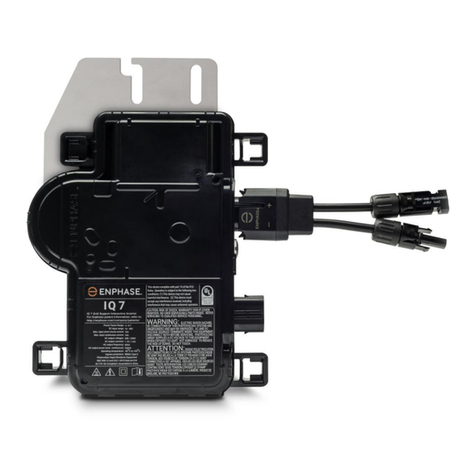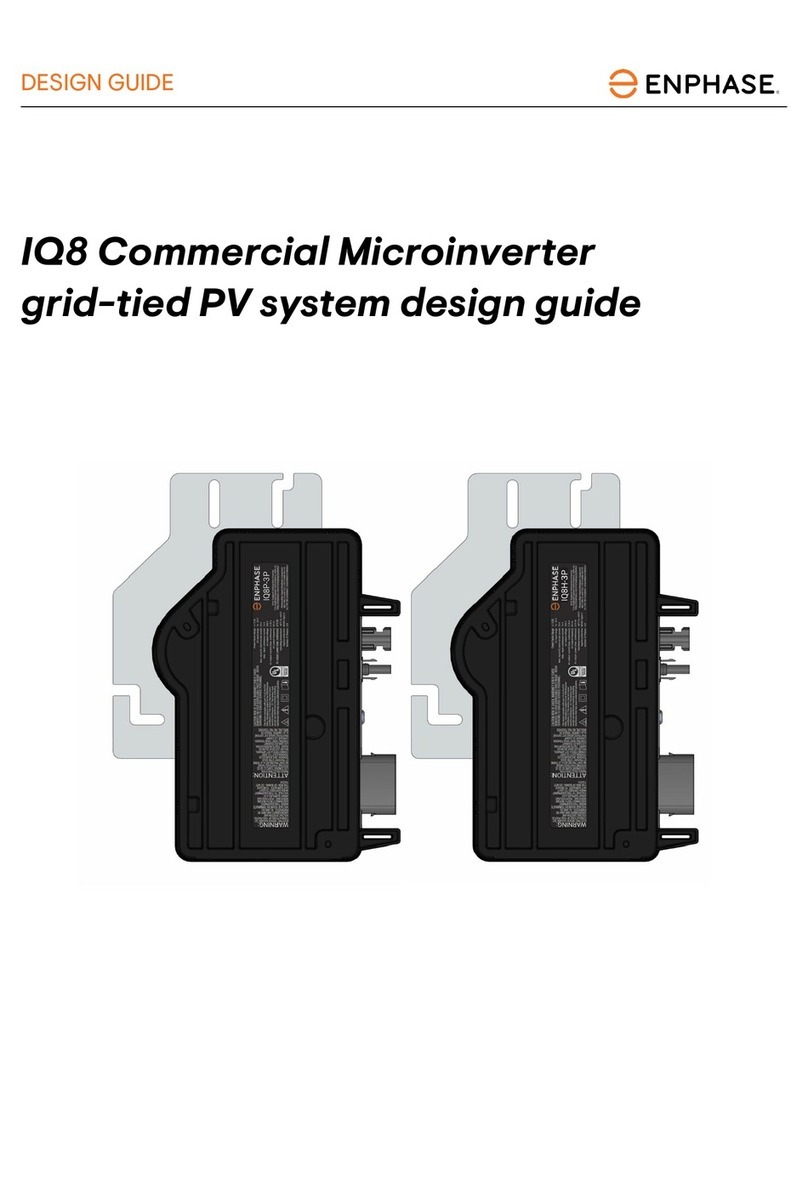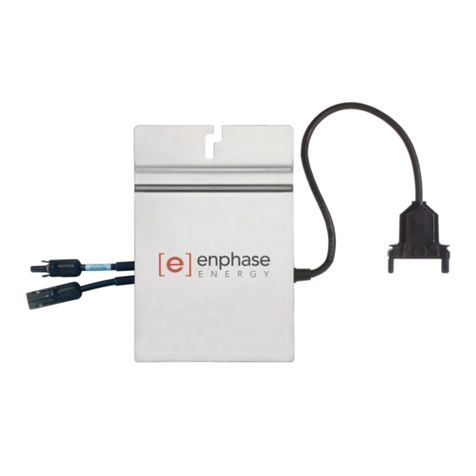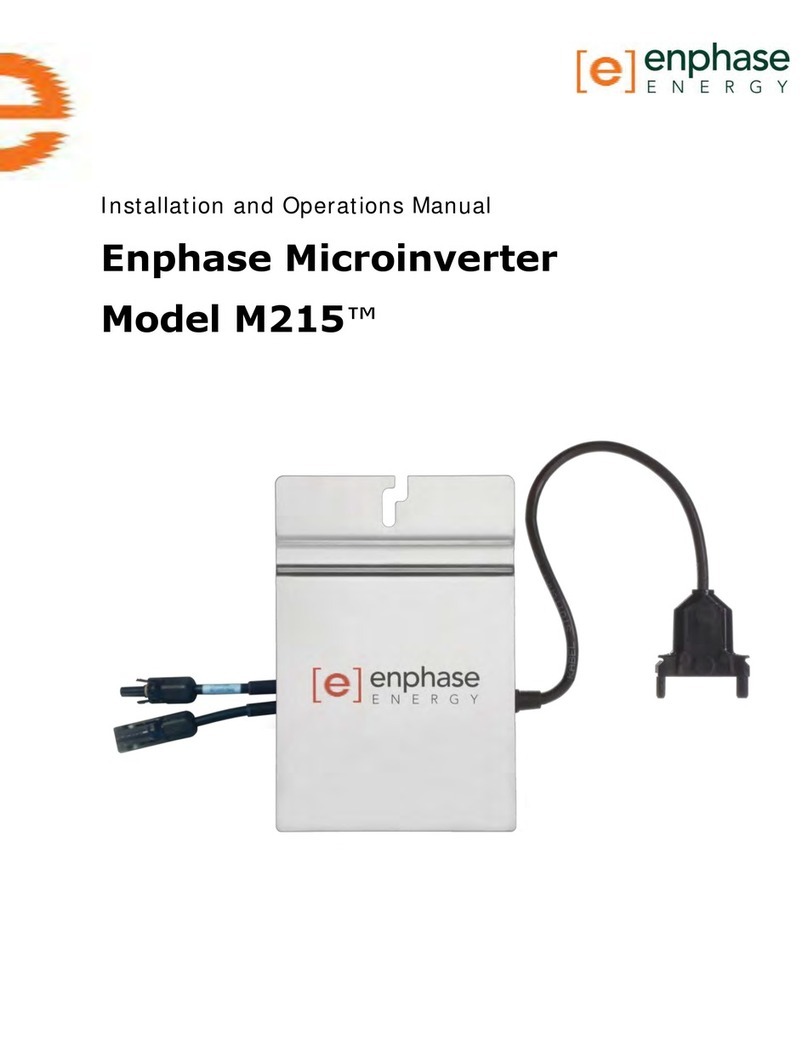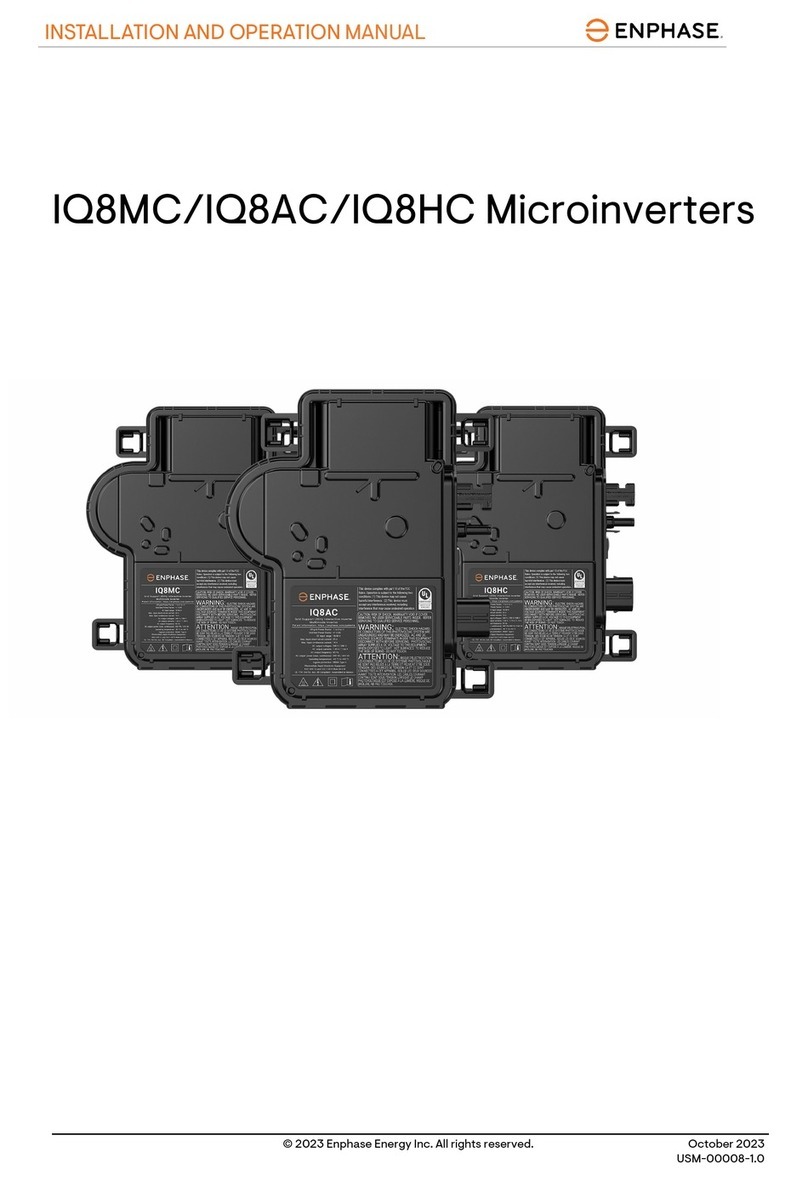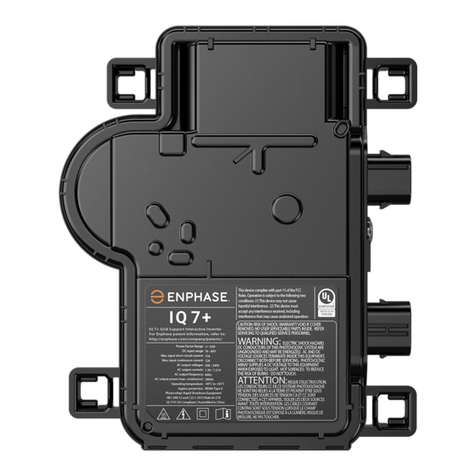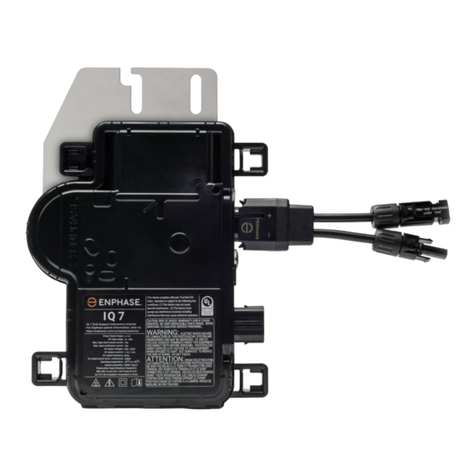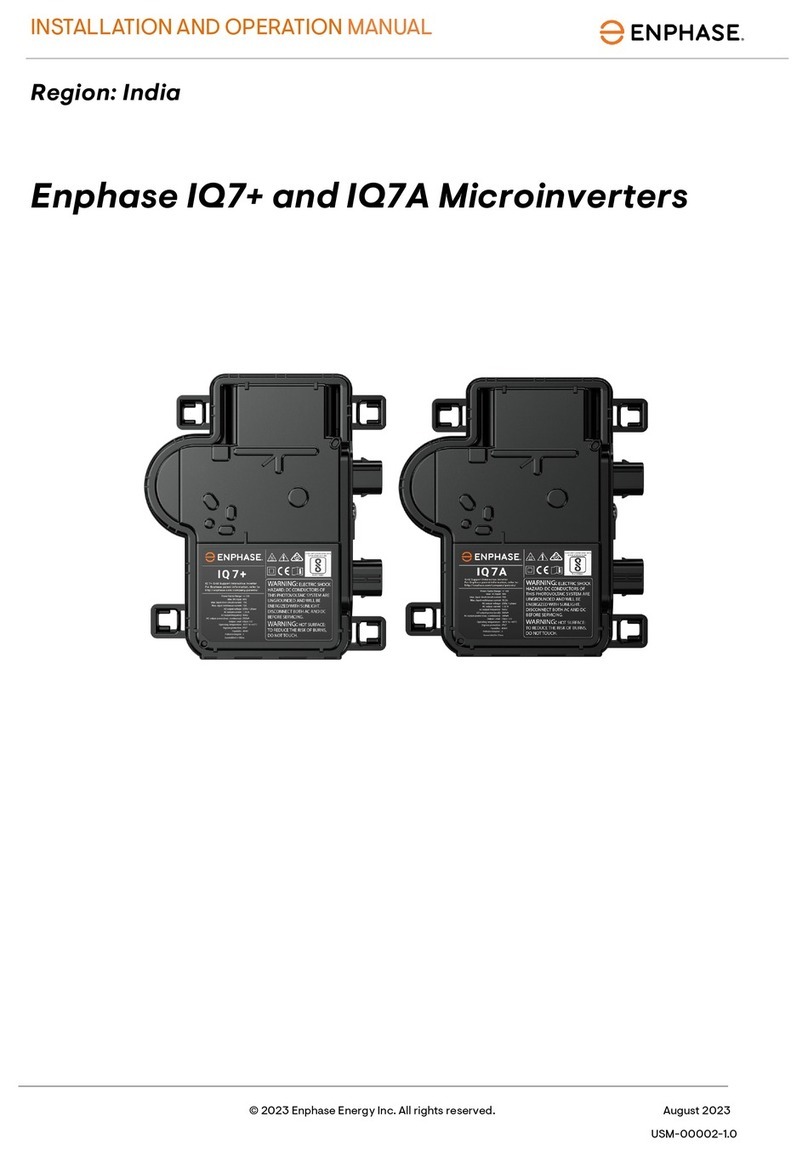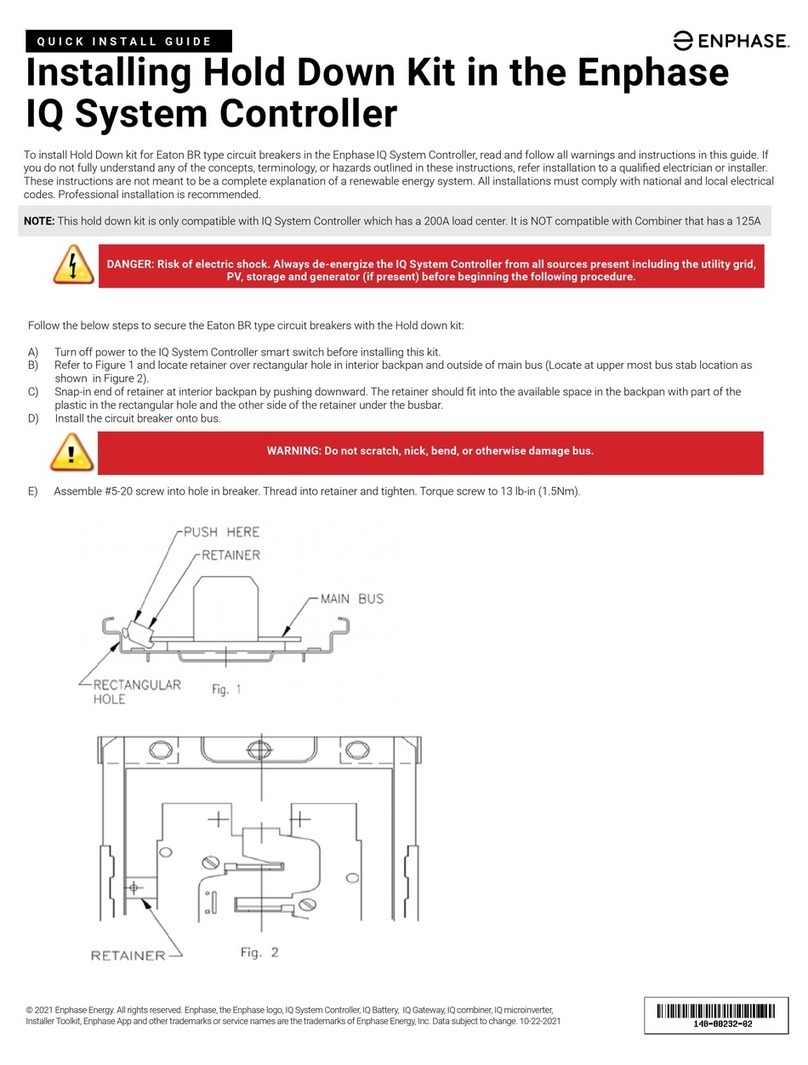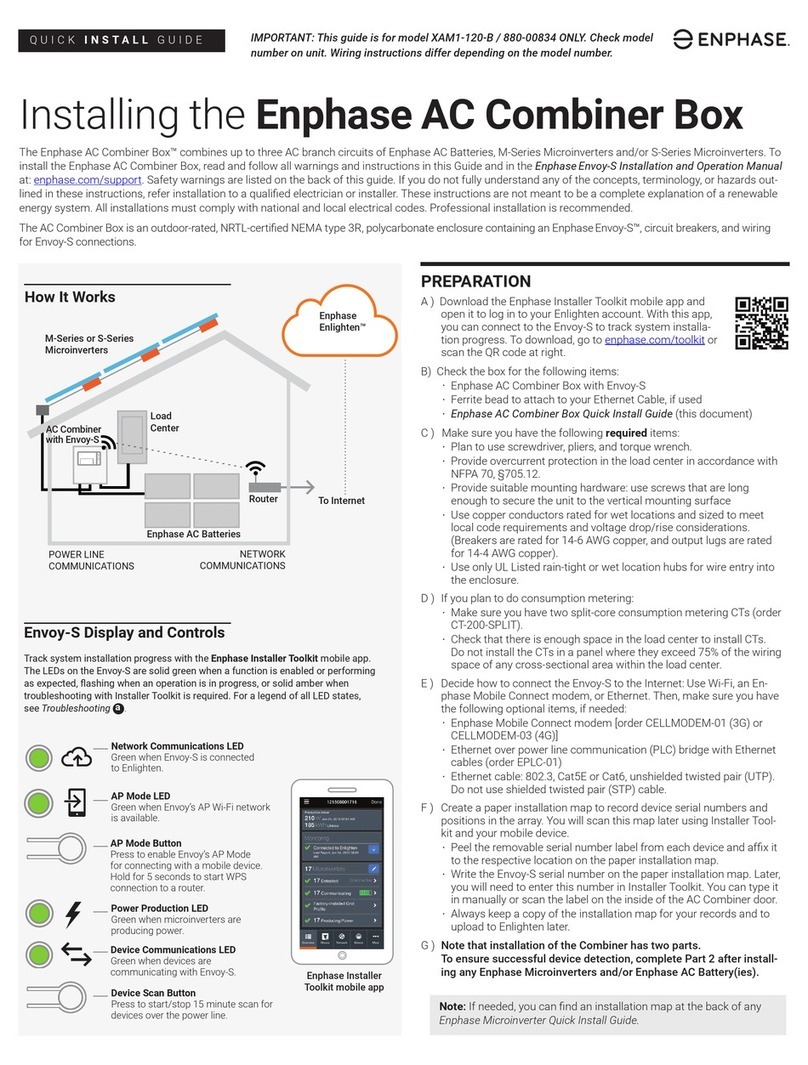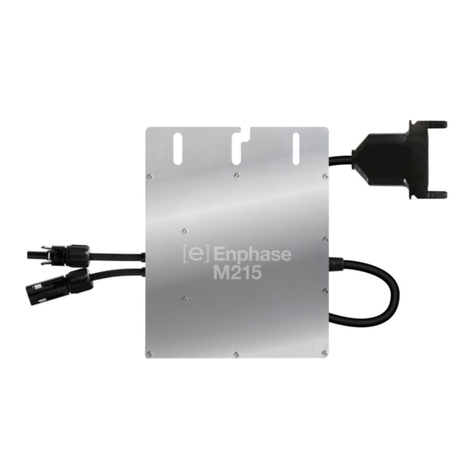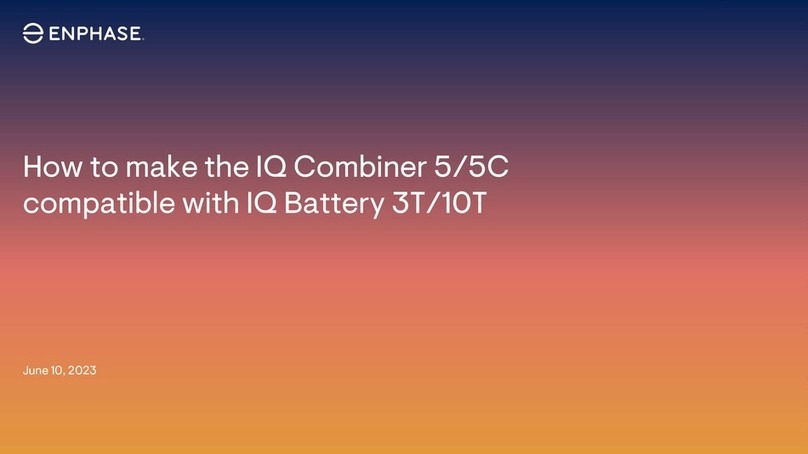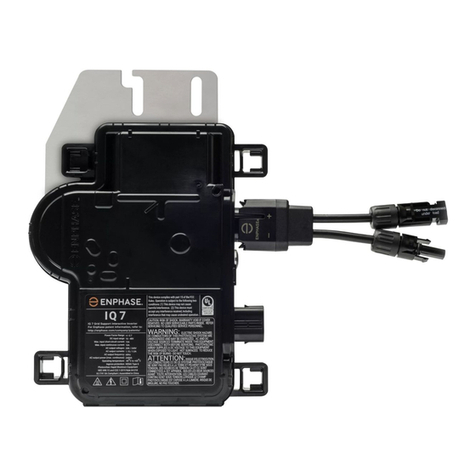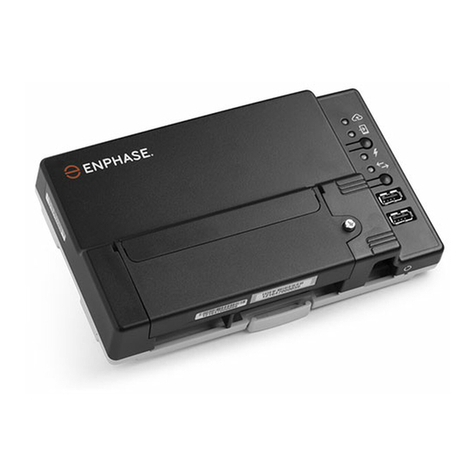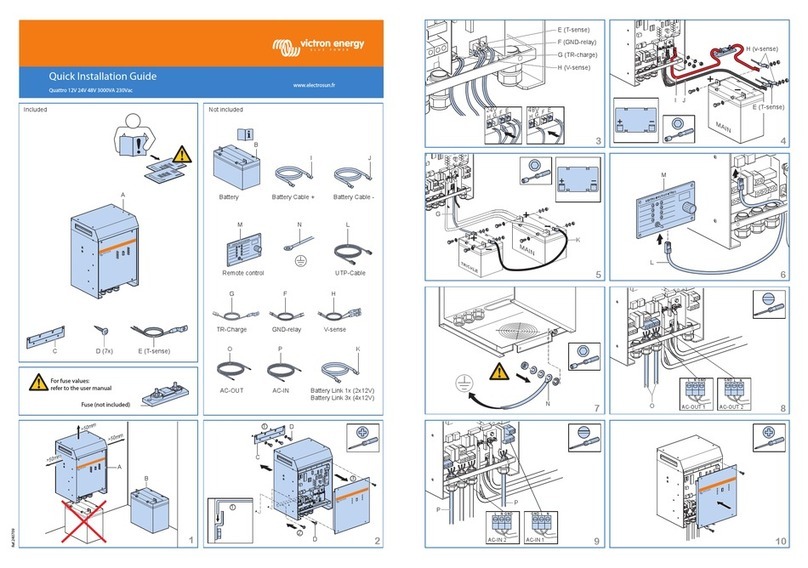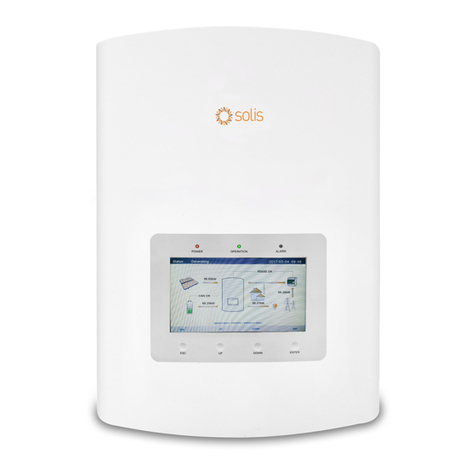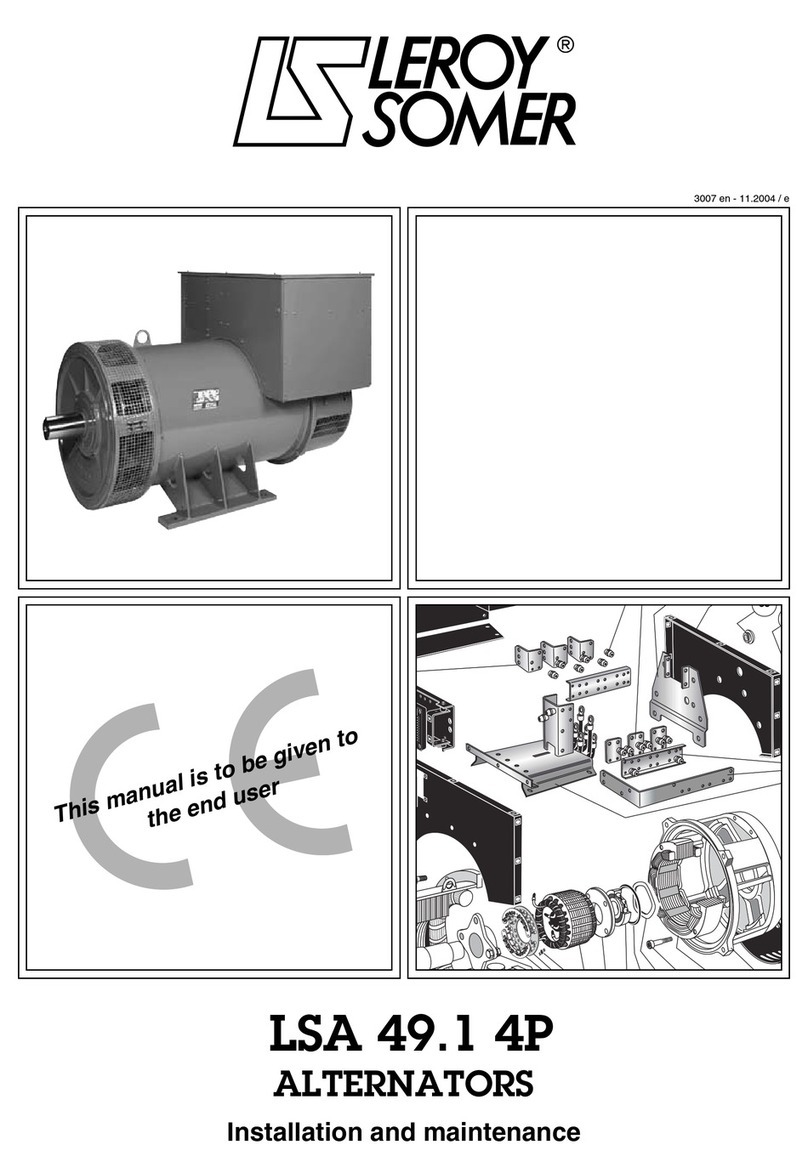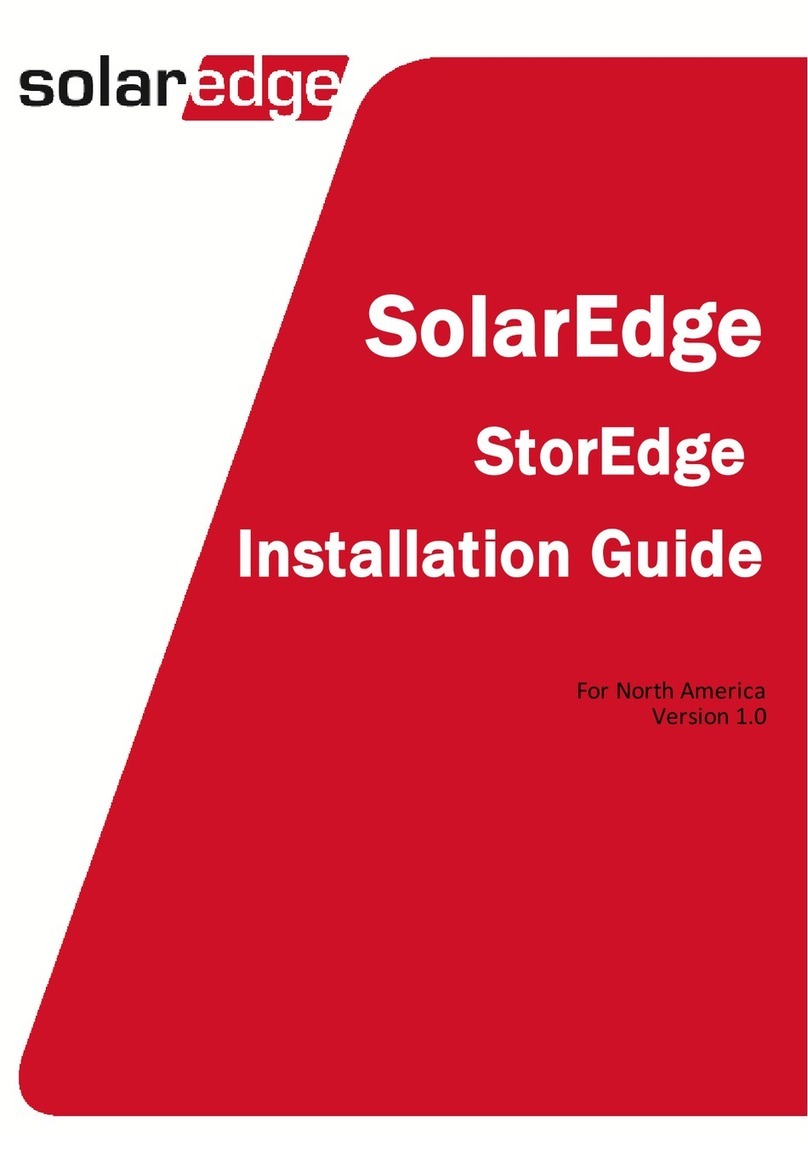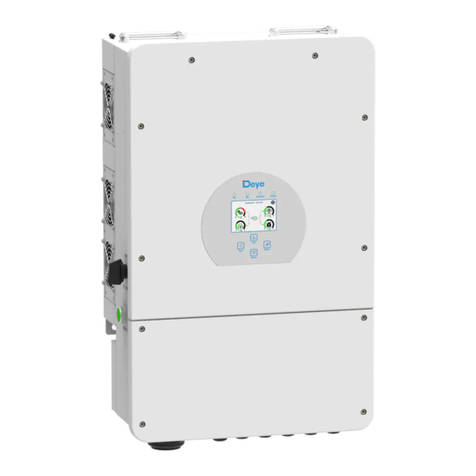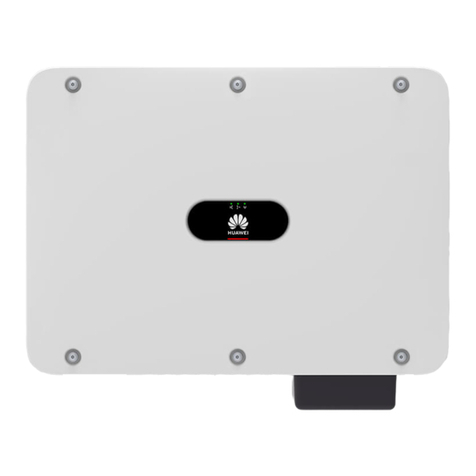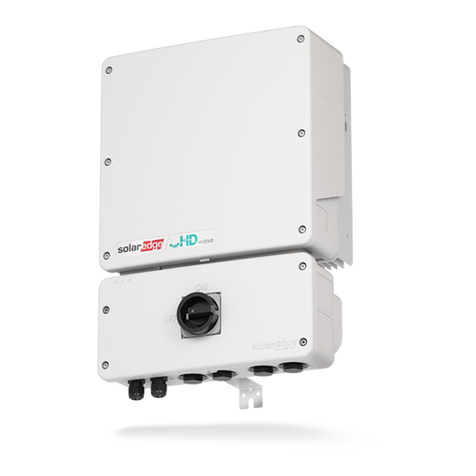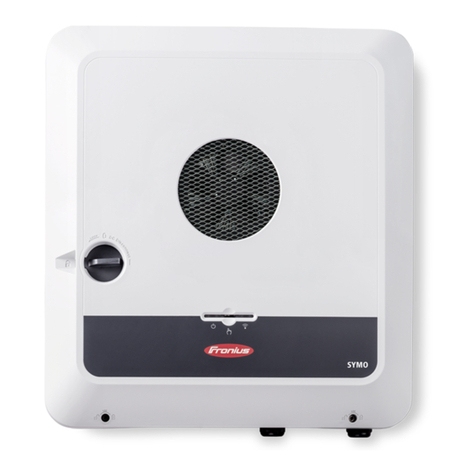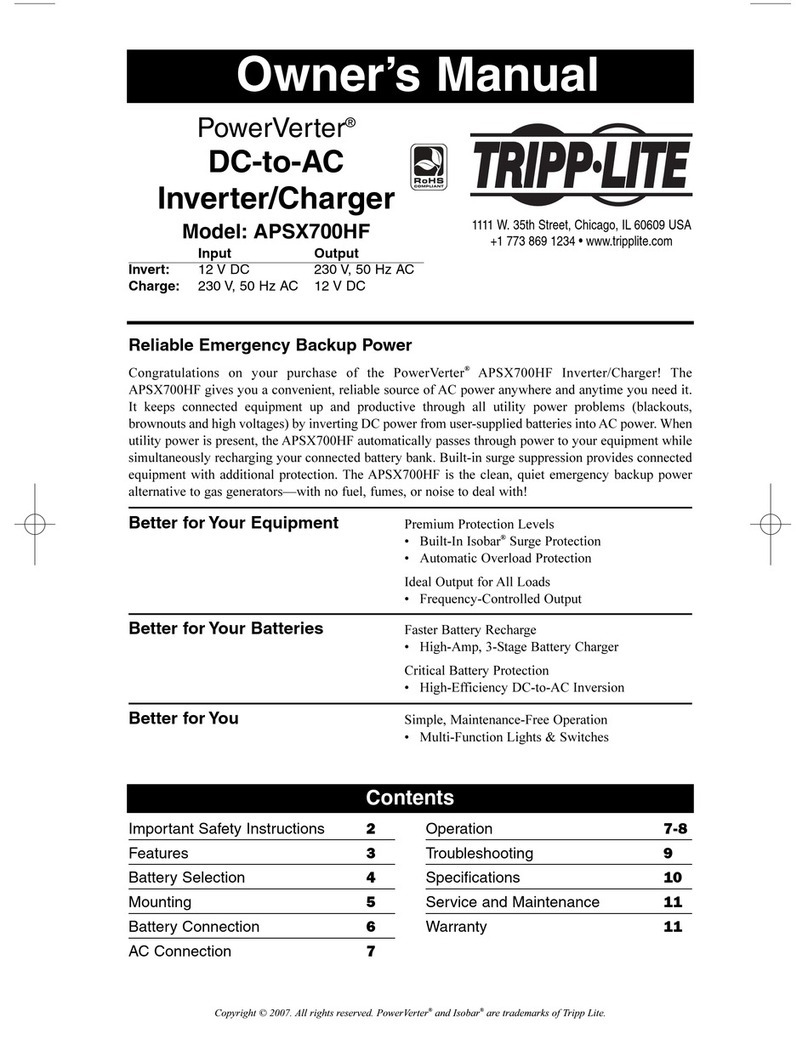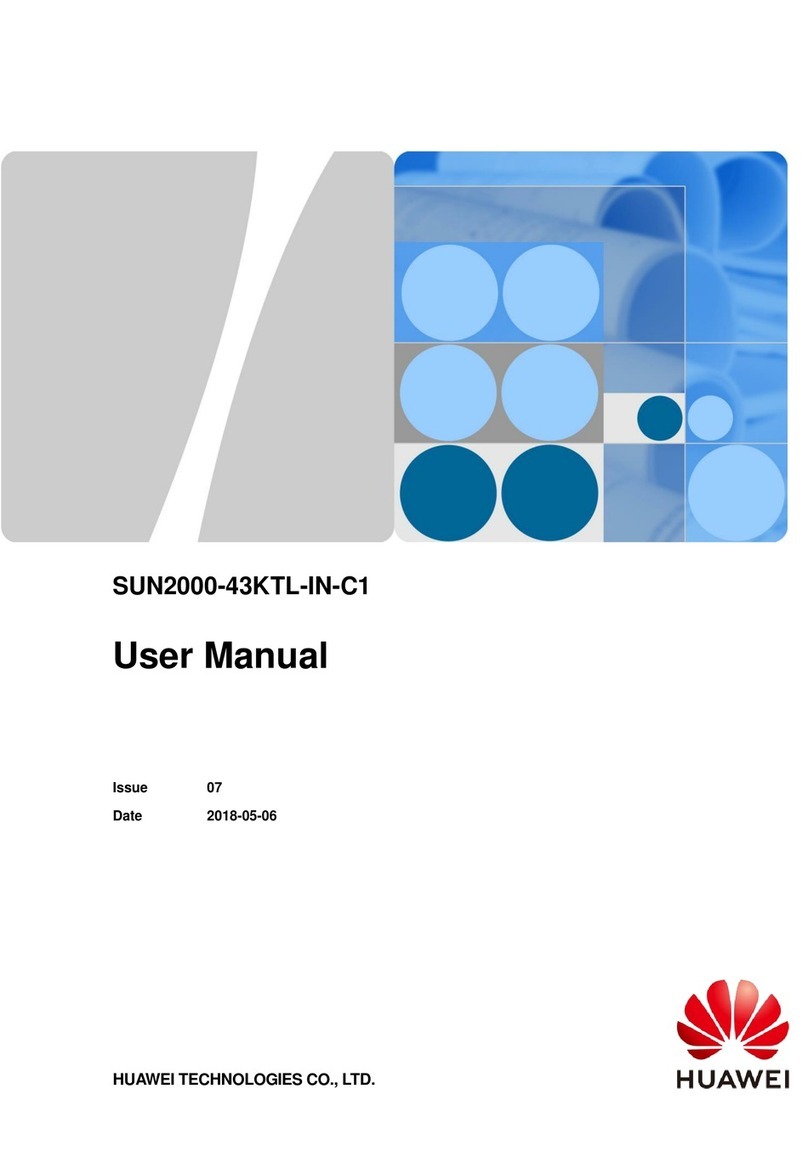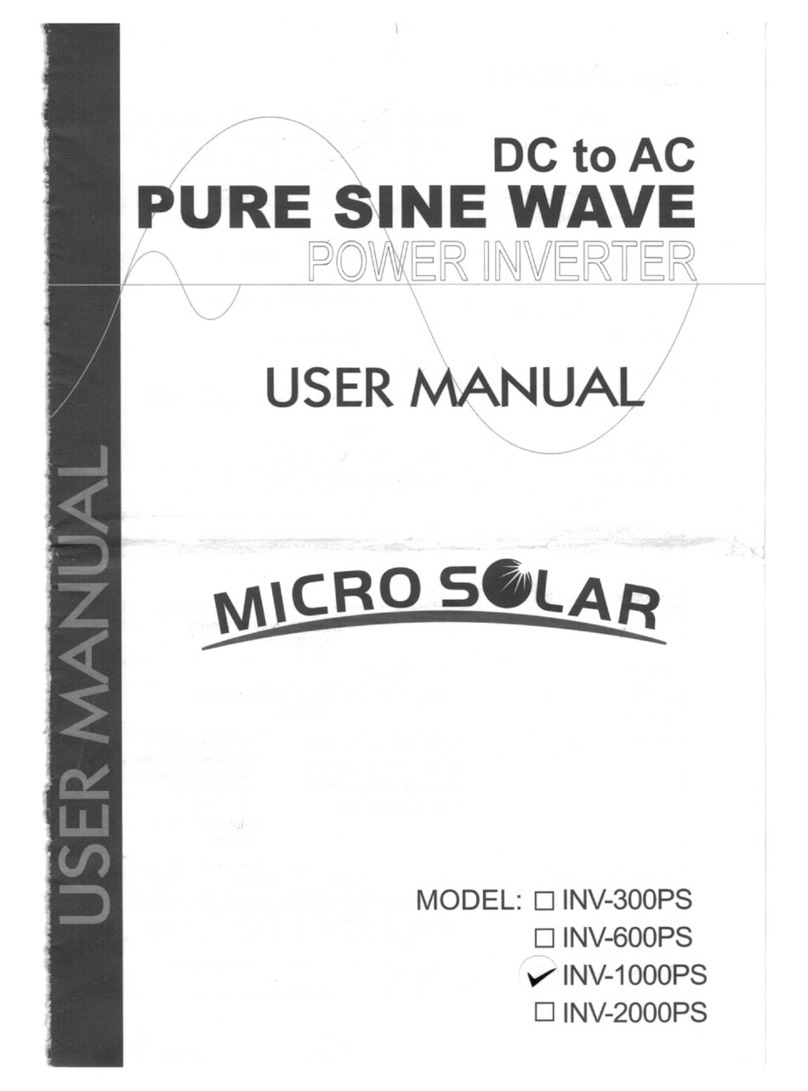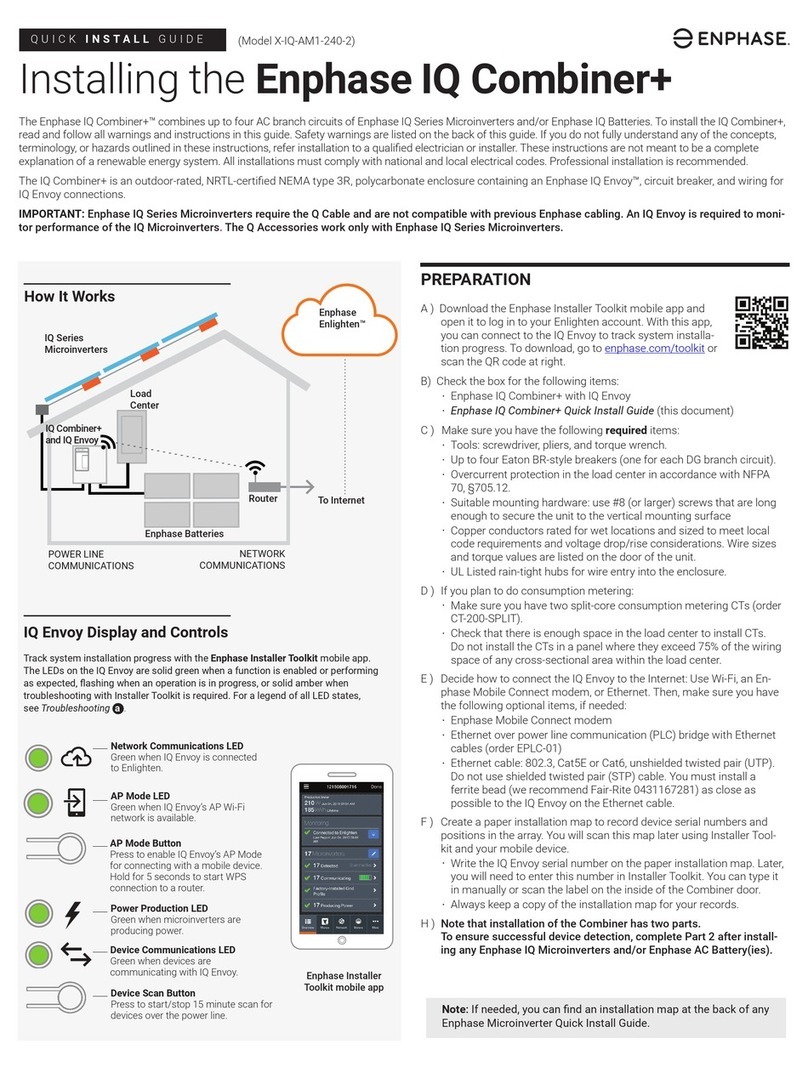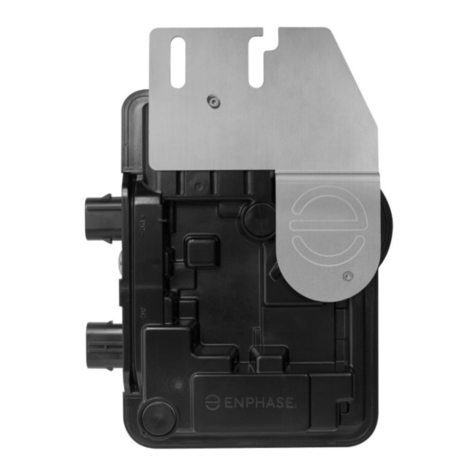
SAFETY
IMPORTANT SAFETY INSTRUCTIONS
SAVE THIS INFORMATION. This guide con-
tains important instructions to follow during installation
of the Enphase S230 and S270 Microinverters.
WARNING: Hot surface.
WARNING: Refer to safety instructions.
DANGER: Risk of electric shock.
Refer to manual
Double-Insulated
General Safety
+DANGER: Risk of electric shock. Do not
use Enphase equipment in a manner not
specied by the manufacturer. Doing so
may cause death or injury to persons, or
damage to equipment.
+DANGER: Risk of electric shock. Be aware
that installation of this equipment includes
risk of electric shock. Do not install the AC
junction box/isolator without rst removing
AC power from the Enphase System.
+DANGER: Risk of electric shock. The DC
conductors of this photovoltaic system are
ungrounded and may be energised.
+DANGER: Risk of electric shock. Always
de-energise the AC branch circuit before
servicing. Never disconnect the DC
connectors under load.
+DANGER: Risk of electric shock. Risk of re.
Only use electrical system components
approved for wet locations.
+DANGER: Risk of electric shock. Risk
of re. Only qualied personnel should
troubleshoot, install, or replace Enphase
Microinverters or the Enphase Cable and
Accessories.
+DANGER: Risk of electric shock. Risk of re.
Ensure that all AC and DC wiring is correct
and that none of the AC or DC wires are
pinched or damaged. Ensure that all AC
junction boxes are properly closed.
+DANGER: Risk of electric shock. Risk of re.
Do not exceed the maximum number of
microinverters in an AC branch circuit as
listed in this guide. You must protect each
microinverter AC branch circuit with a 20A
maximum breaker or fuse, as appropriate.
+DANGER: Risk of electric shock. Risk of re.
Only qualied personnel may connect the
Enphase Microinverter to the utility grid.
*WARNING: Risk of equipment damage.
Enphase male and female connectors must
only be mated with the matching male/
female connector.
*WARNING: Before installing or using the
Enphase Microinverter, read all instructions
and cautionary markings in the technical
description, on the Enphase Microinverter
System, and on the photovoltaic (PV)
equipment.
*WARNING: Do not connect Enphase
Microinverters to the grid or energise the
AC circuit(s) until you have completed all
of the installation procedures and have
received prior approval from the electrical
utility company.
Microinverter Safety
+DANGER: Risk of electric shock. Risk of
re. Do not attempt to repair the Enphase
Microinverter; it contains no user-ser-
viceable parts. If it fails, contact Enphase
customer service to obtain an RMA (return
merchandise authorization) number and
start the replacement process. Tampering
with or opening the Enphase Microinverter
will void the warranty.
+DANGER: Risk of re. The DC conductors of
the PV module must be labeled “PV Wire”
or “PV Cable” when paired with the Enphase
Microinverter.
*WARNING: You must match the DC
operating voltage range of the PV module
with the allowable input voltage range of
the Enphase Microinverter.
*WARNING: The maximum open circuit
voltage of the PV module must not exceed
the specied maximum input DC voltage of
the Enphase Microinverter.
*WARNING: Risk of equipment damage.
Install the microinverter under the PV
module to avoid direct exposure to rain, UV,
and other harmful weather events. Always
install the microinverter bracket side up. Do
not mount the microinverter upside down.
Do not expose the AC or DC connectors (on
the Enphase Cable connection, PV module,
or the microinverter) to rain or condensa-
tion before mating the connectors.
*WARNING: Risk of equipment damage. The
Enphase Microinverter is not protected from
damage due to moisture trapped in cabling
systems. Never mate microinverters to
cables that have been left disconnected and
exposed to wet conditions. This voids the
Enphase warranty.
*WARNING: Risk of equipment damage.
The Enphase Microinverter functions only
with a standard, compatible PV module
with appropriate ll-factor, voltage, and
current ratings. Unsupported devices include
smart PV modules, fuel cells, wind or water
turbines, DC generators, and non-Enphase
batteries, etc. These devices do not behave
like standard PV modules, so operation and
compliance is not guaranteed. These devices
may also damage the Enphase Microinverter
by exceeding its electrical rating, making the
system potentially unsafe.
;WARNING: Risk of skin burn. The chassis
of the Enphase Microinverter is the heat
sink. Under normal operating conditions,
the temperature could be 20°C above
ambient, but under extreme conditions the
microinverter can reach a temperature of
90°C. To reduce risk of burns, use caution
when working with microinverters.
✓NOTE: Many Enphase Microinverter models
have eld-adjustable voltage and frequency
trip points that may need to be set, depending
upon local requirements. Only an authorised
installer with the permission and following
requirements of the local electrical authorities
should make adjustments.
Enphase Cable Safety
+DANGER: Risk of electric shock. Do not
install the Enphase Cable terminator while
power is connected.
+DANGER: Risk of electric shock. Risk of
re. When stripping the sheath from the
Enphase Cable, make sure the conductors
are not damaged. If the exposed wires are
damaged, the system may not function
properly.
+DANGER: Risk of electric shock. Risk of re.
Do not leave AC connectors on the Enphase
Cable uncovered for an extended period. You
must cover any unused connector with a
sealing cap.
+DANGER: Risk of electric shock. Risk of re.
Make sure protective sealing caps have
been installed on all unused AC connectors.
Unused AC connectors are live when the
system is energised.
*WARNING: Use the terminator only once. If
you open the terminator following installation,
the latching mechanism is destroyed. Do
not reuse the terminator. If the latching
mechanism is defective, do not use the
terminator. Do not circumvent or manipulate
the latching mechanism.
*WARNING: When installing the Enphase
Cable, secure any loose cable to minimise
tripping hazard
✓NOTE: When looping the Enphase Cable,
do not form loops smaller than 12 cm in
diameter.
✓NOTE: If you need to remove a sealing cap,
you must use the Enphase Disconnect
Tool.
✓NOTE: When installing the Enphase Cable and
accessories, adhere to the following:
• Do not expose the terminator or cable
connections to directed, pressurised liquid
(water jets, etc.).
• Do not expose the terminator or cable
connections to continuous immersion.
• Do not expose the terminator or cable
connections to continuous tension (e.g.,
tension due to pulling or bending the cable
near the connection).
• Use only the connectors and cables
provided.
• Do not allow contamination or debris in the
connectors.
• Use the terminator and cable connections
only when all parts are present and intact.
• Do not install or use in potentially explosive
environments.
• Do not allow the terminator to come into
contact with open ame.
• Fit the terminator using only the prescribed
tools and in the prescribed manner.
• Use the terminator to seal the conductor
end of the Enphase Cable; no other method
is allowed.
Safety Symbols
+DANGER: Indicates a hazardous situation,
which if not avoided, will result in death or
serious injury.
*WARNING: Indicates a situation where
failure to follow instructions may be
a safety hazard or cause equipment
malfunction. Use extreme caution and
follow instructions carefully.
;WARNING: Indicates a situation where
failure to follow instructions may result in
burn injury.
✓NOTE: Indicates information particularly
important for optimal system operation.
General Safety, continued
*WARNING: When the PV array is exposed
to light, DC voltage is supplied to the PCE.
✓NOTE: To ensure optimal reliability and to
meet warranty requirements, install the
Enphase Microinverters and Enphase Cable
according to the instructions in this guide.
✓NOTE: Perform all electrical installations
in accordance with all applicable local
electrical codes.
✓NOTE: The AC and DC connectors on the
cabling are rated as a disconnect only when
used with an Enphase Microinverter.
✓NOTE: Protection against lightning
and resulting voltage surge must be in
accordance with local standards.
Note for third-party products
Any third-party manufacturer or importer product(s)used
to install or commission Enphase product(s) shall comply
with the applicable EU Directive(s) and requirements in
the EEA (European Economic Area). It is the responsibility
of the installer to conrm that all such products are
labelled correctly and have the required compliant
supporting documentation.
Manufacturer:
Enphase Energy Inc.,
47281 Bayside Pkwy., FREMONT, CA, 94538,
UNITED STATES of AMERICA, PH: +1 707-763-4784
Importer:
Enphase Energy NL B.V.,
Het Zuiderkruis 65, 5215MV, ‘s-HERTOGENBOSCH,
THE NETHERLANDS, PH: +31 73 3035859
Compliance with EU Directives
This product complies with the following EU Directives and
can be used in the European Union without any restrictions.
• Electro Magnetic Compatibility (EMC) directive 2014/30/EU
• Low Voltage Directive (LVD) 2014/35/EU
• Restriction of Hazardous Substances (RoHS) 2011/65/EU
The full text of the EU declaration of conformity (DoC) is
available at the following internet address https://enphase.
com/en-au/installers/resources/documentation.
Enphase Customer Support: https://enphase.com/contact/support





